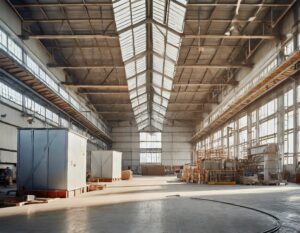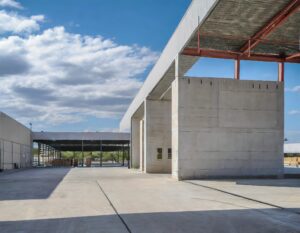Page Contents
- Impact of Manufacturing Growth on Austin’s Industrial Market
- Supply-Demand Imbalance and Market Implications
- Decline in Leasing Activity
- Positive Long-Term Demand Outlook
- Rising Sublease Availabilities and Vacancy Rates
- Slowdown in Rent Growth Amidst Surging Supply
- Stabilizing Rents and Economic Resilience
- Construction Pipeline Risks
- Resurgence in Speculative Development and Construction Slowdown
- Future Trends in Construction and Delivery
- Williamson County’s Growth and Development Focus
- Sustained Investor Interest in Austin’s Industrial Market
- Sales Focus on Hays County & Georgetown Submarkets
- Notable Sales and Investment Trends
- Closing Thoughts
Impact of Manufacturing Growth on Austin’s Industrial Market
Austin’s manufacturing sector, boosted by companies like Samsung and Tesla, has driven industrial demand. This has led to an increase in speculative development, raising the risk of market oversupply amidst slowing demand. These developments are occurring against a backdrop of broader economic challenges.
Supply-Demand Imbalance and Market Implications
The expansion of major manufacturers has spiked demand, but there’s a concerning rise in speculative development, leading to a low prelease rate and potential oversupply. The resultant increase in vacancy rates could impact landlords’ pricing power despite a strong year of rent growth. Investor activity has slowed, indicating caution in the face of these market dynamics.
resultant increase in vacancy rates could impact landlords’ pricing power despite a strong year of rent growth. Investor activity has slowed, indicating caution in the face of these market dynamics.
Decline in Leasing Activity
New leasing volume in Austin has significantly decreased, with a 46% quarter-over-quarter drop and a 45% fall from the five-year quarterly average. The average lease size has shrunk to 9,000 SF, compared to 13,000 SF in the past year. This slowdown in leasing led to a net absorption of only 784,000 SF in 23Q1, the lowest since 20Q2, despite CoStar’s forecast of a potential rebound.
Positive Long-Term Demand Outlook
Despite current challenges, the long-term demand outlook in Austin remains positive, driven by a growing population and significant leases by companies like Spec’s Wine and 3-Way Logistics. Spec’s Wine’s 160,000 SF lease in the Southeast Submarket is the largest deal of 2023. The Southeast and North submarkets, key areas for last-mile delivery, accounted for nearly half of this year’s deals.
Rising Sublease Availabilities and Vacancy Rates
Sublease availabilities in Austin are nearing their third-highest level since 2005, currently standing at 1.2 million SF. However, this represents only 0.9% of the total industrial inventory, posing less risk compared to the office sector. The expected completion of new constructions without tenants will likely increase vacancies to 7.3% by the end of 2023. New deliveries outpace net absorption, making it one of the highest vacancy rates among major U.S. markets.
Slowdown in Rent Growth Amidst Surging Supply
Austin’s industrial market is facing a slowdown in year-over-year rent growth, expected to underperform the national average due to a significant surge in new supply. The market has seen one of the most considerable inventory expansions among major U.S. markets, growing over 8% in the past year. This expansion, combined with a disparity between net deliveries and net absorption, puts pressure on the vacancy rate and contributes to short-term oversupply.
Stabilizing Rents and Economic Resilience
The vacancy rates, anticipated to rise to 7.1%, will likely surpass the national average, with an additional increase of 2.5% expected by the end of 23Q4. However, despite these challenges, average gross rents will likely stay stable, with a slight decrease to $14.26/SF by the year’s end. Despite these challenges, average gross rents are expected to remain stable, only slightly decreasing to $14.26/SF by year’s end. This stability is partly due to Austin’s diverse and robust economy, which has shown one of the fastest recovery rates nationally.
Construction Pipeline Risks
 Austin’s large construction pipeline poses a significant risk to the market, with over 9.5 million SF of unleased space underway, marking one of the largest unleased pipelines in the city’s history. This surplus could lead to higher-than-anticipated vacancy rates. If this scenario unfolds, landlords may need to restrain rent increases to maintain occupancy levels.
Austin’s large construction pipeline poses a significant risk to the market, with over 9.5 million SF of unleased space underway, marking one of the largest unleased pipelines in the city’s history. This surplus could lead to higher-than-anticipated vacancy rates. If this scenario unfolds, landlords may need to restrain rent increases to maintain occupancy levels.
Resurgence in Speculative Development and Construction Slowdown
Austin has experienced a surge in speculative development, with 17.1 million SF of construction underway, led by developers like Alliance Industrial Company and Titan Development. However, the high cost of capital has caused a decline in new construction starts in 2023, leading to a halt in many proposed projects. This slowdown will likely mitigate oversupply risks and prevent a significant vacancy increase.
Future Trends in Construction and Delivery
Starting from 24Q2, the volume of new construction deliveries in Austin will likely decline, aligning more closely with the 10-year average. The trailing 12-month net deliveries will likely reduce from 12.6 million SF in 24Q1 to 5.2 million SF by the end of 2024. This shift significantly modifies the pace of new industrial space entering the market.
Williamson County’s Growth and Development Focus
Williamson County is leading the construction boom, with 50% of Austin’s industrial space under construction. The county’s rapid population growth and attractive economic incentives are drawing developers and tenants. The area is also poised to benefit from the new six million-SF Samsung semiconductor factory in Taylor, which will likely attract various ancillary suppliers.
Sustained Investor Interest in Austin’s Industrial Market
Investors remain keenly interested in Austin’s industrial market, driven by its strong economic performance and growth prospects. The second half of 2022 saw a sales volume of $342 million, exceeding long-term averages. International and national investors, attracted by Austin’s low vacancy rates and high-profile corporate relocations, have invested in nearly 8 million SF of assets in the area this year, with a significant portion of this activity occurring in the fourth quarter.
Sales Focus on Hays County & Georgetown Submarkets
Hays County and Georgetown submarkets have been central to Austin’s industrial sales over the past year, accounting for nearly half of all sales. These submarkets’ popularity among buyers reflects their development activity, being the second and third most active areas in terms of construction. This trend indicates a strong alignment between regions of high construction activity and investor interest.
Notable Sales and Investment Trends
The largest sale in the past year was the 294,000-SF Gateway35 Commerce Center Building 1 in Georgetown, highlighting the focus on substantial properties. This building, fully leased to CelLink, was acquired by Property Reserve Inc. for an undisclosed amount. This sale underscores the trend of significant investments in fully leased, strategically located properties within the Austin market.
Closing Thoughts
As the Austin industrial market continues to evolve, it presents unique opportunities and challenges for investors. For those looking to navigate this dynamic landscape and capitalize on investment sales opportunities, Lumicre offers expert guidance and tailored solutions. Contact Lumicre for your investment sales needs to harness the potential of Austin’s thriving market.